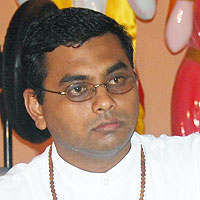From temple to temple the same forms of God can be found but they are slightly different in appearances. The artists or sculptors carve the forms in their own style which account for variations in the way they look. Yet, the names remain the same. Indeed the name Shiva remains Shiva, no matter the differences in appearances from murti to murti. Similarly, Vishnu remains Vishnu, and so it is with all names of God through the ages. Indeed, the names of God are mahaa mantras.
The name of God is superior to the form. Evidence of this statement can be found in scriptures where the repetition of the name brought enlightenment, freedom from struggles and salvation to many devotees. In Ramaayana, Shri Tulsidas explained that Shri Raam Himself liberated a few, but His name liberated countless. Again in Shiva Puraana it is recorded that Upamanyu, a five year old child was able to have the ‘darshan’(appearance) of Lord Shiva by continuous repetition of the Panchakshara Mantra that was taught to him by his mother. Child devotees Dhruva and Prahalad came face to face with the Divine through repetition of His name.
The question may be asked as to what kind of power lies behind these names of the Divine, these mahaa mantras. A breakdown of the word ‘mantra’ may bring some answers. Mantra is comprised of ‘man’-meaning mind and ‘tra’- meaning an instrument or tool. A mantra then is an instrument of thought.
The names of the various deities are in Sanskrit. Each letter relates to a particular chakra or energy centre in the body. By the recitation of the name, different energy centres are activated, from which the energy flows through the 72,000 nadis that criss-cross the subtle body, awakening the inner force or shakti that enables greater awareness of one’s true nature. One may not be aware of these inner movements but the results are clear. Ratnakar was unaware he was repeating the name of ‘Raam’, yet he was transformed to Sage Valmiki, Adikavi, the foremost of poets.
Continuous repetition of the name of God purifies the mind of the one who repeats it, as well as cleanses the environment wherever it is done. Mantras are meant for practice. They are like seeds that need to be sown, watered and fertilized . The more they are repeated, the more effective they become. Mantras can be recited aloud, softly or in the mind. They can also be written.
As a tool of transformation, mantras are most useful in one’s life. It is one of the nine types of devotion outlined by Shri Raam to Shavari in Raaamayan. To schedule the act of mantra-recitation in one’s daily routine is to become engaged in a practice that will sustain, uplift and purify one’s environment as well as oneself. No doubt, the form has inspired many. The name, on the other hand, is a most potent instrument of thought.
It is said that the surest, safest and the easiest means of expiating sins in this age is repetition of the name of the Divine.
Durga Devi mantras that can be recited during the period of Nava Raatri ( March 20-28, 2015)
Om Sarva Mangala Maangalyay
Shivay Sarvaartha Saadhikay
Sharanyay Trayambikay Gauri
Naaraayani Namostutay
Om Jayanti Mangala Kaali
Bhadrakaali Kapaalini
Durgaa Kshamaa Shivaa Dhaatri
Swaahaa Swadhaa Namostutay
Om Jai Twam Devi Chaamunday
Jai Bhutaar-tihaarini
Jai Sarvagatay Devi
Kaalraatri Namostutay
Om Namas Chandikaayai
Om Hreem Sreem Chandikaayai Namah


